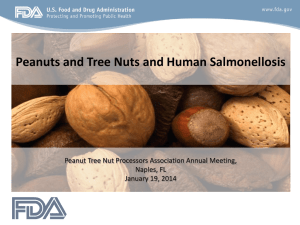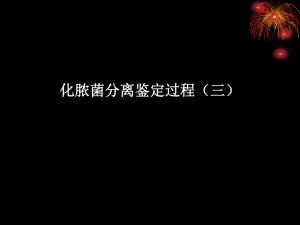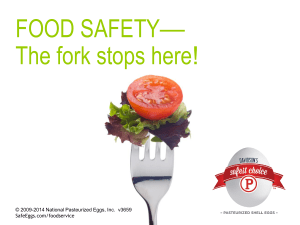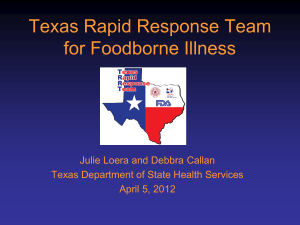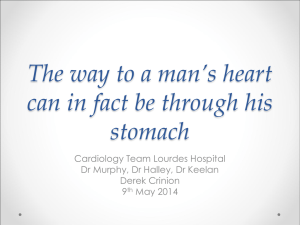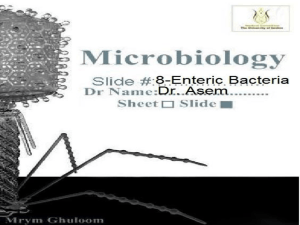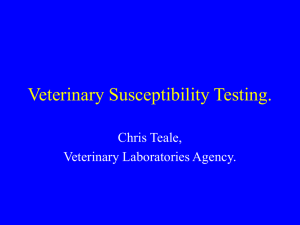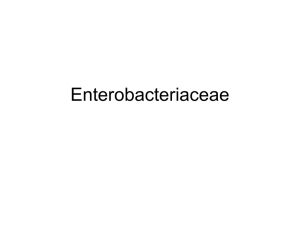CD-SL presentation
advertisement
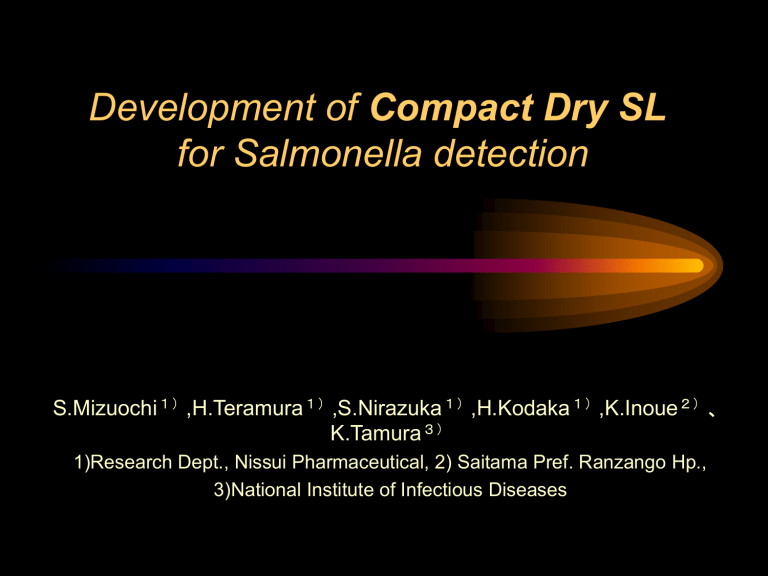
Development of Compact Dry SL for Salmonella detection S.Mizuochi1),H.Teramura1),S.Nirazuka1),H.Kodaka1),K.Inoue2)、 K.Tamura3) 1)Research Dept., Nissui Pharmaceutical, 2) Saitama Pref. Ranzango Hp., 3)National Institute of Infectious Diseases Background • Normally, Salmonella detection from food sample is processed these following steps, Pre-culture, Selective enrichment culture, Isolation and Confirmation/Identification. There are strong customer demands to improve the test procedure for more simple and rapid one, if it could have an equivalent result. • We develop simple and easy medium for Salmonella detection (Compact Dry SL, hereinafter CDSL) that detects Salmonella by combination of biochemical reaction, specific enzyme reaction and detection of motility of Salmonella. CDSL is screening method for detecting Salmonella which inoculate pre-culture sample as a specimen. • Herewith we report CDSL evaluation results compared with conventional culture methods using meats on the market, ① growth and color forming used by pure culture strains ② recovery of Salmonella from food materials ③ comparison (sensitivity/specificity/agreement) between conventional method and CDSL Package, CDSL Comparison of operation between conventional method and CDSL Conventional CDSL Day 1 Specimen 25g Pre-culture (BPW/EEM) ↓ Specimen 25g Pre-culture (BPW/EEM) ↓ Day 2 Selective Enrichment Culture CDSL Day 3 (TT/RV/SBG/SC) ↓ Isolation (MLCB/DHL/XLD/Rambach) ↓ Day 4 Presume, presence of Salmonella Confirmation/Identification (Biochemical/Serological Tests) ↓ Presume, presence of Salmonella Isolation ↓ Confirmation/Identification (Biochemical/Serological Tests) Operating procedure of CDSL (1) Pre-culture Medium (BPW,EEM) Sample 25g Pre-incubation 20-24 hours at 35℃ Inoculate 0.1mL of Pre-culture solution on CDSL (approx. 1cm far from the edge of plate) × SL Operating procedure of CDSL (2) Drop 1mL of sterilized water at the opposite point where specimen dropped. ↓ Confirm water diffused all over the plate and turn over the plate capped. Incubate 20 – 24 hours at 41 - 43℃. ↓ Interpretation × SL Test Principle and Features of Compact Dry SL • Base medium: DHL agar • Additives: Pigment / Magnesium chloride / Novobiocin / Other additives • Test principle: 1) Medium alkalization that changes medium color from blue-purple to yellow by Salmonella’s lysine decarboxylase ability. 2) Colony color will be greening caused by decomposition of chromogenic substrate with specific enzyme on Salmonella. 3) Salmonella produces hydrogen (not all strains) sulfide which generate black colonies. 4) Detect motility of Salmonella. • Features: 1) CDSL detects Salmonella one day earlier than conventional culture methods. 2) Isolated colonies on the plate can be fished for further identification tests. 3) Ready to use and portable plate which no need to special preparation. Chicken (42℃, 24 hours incubation) Positive reaction Negative reaction Motility, Yellow sheet, Greening colony, Black colonies are generated by hydrogen sulfide. No color change Red – Red purple CDSL reactions (1) Standard strains Table 1: Gram Positive bacteria and Yeast (24 hours incubation at 42℃) CDSL Tested strains 1 Bacillus cereus ATCC 19637 2 Bacillus licheniformis ATCC 14580 3 Bacillus subtilis ATCC 6633 4 Corynebacterium minutissium ATCC 23348 5 Corynebacterium renale ATCC 19412 6 Corynebacterium xerosis ATCC 373 7 Enterococcus avium ATCC 14025 8 Enterococcus durans ATCC 19432 9 Enterococcus faecalis ATCC 19433 10 Enterococcus faecalis NIH 1001 11 Enterococcus faecium ATCC 19434 12 Enterococcus faecium NIH 2001 13 Lactobacillus delbrueckii subsp. Lactis ATCC 12315 14 Micrococcus luteus ATCC 9341 15 Staphylococcus aureus ATCC 6538 16 Staphylococcus epidermidis ATCC 14990 17 Streptococcus thermophilus ATCC 14485 18 Candida albicans ATCC 10231 19 Saccharomyces cerevisiae NHL 10010 Growth Color - - CDSL reactions (2) Gram Negative Bacteria rather than Salmonella Table 2: Gram Negative Bacteria rather than Salmonella Tested strains Numbers Growth Color Tested strains Numbers Growth Color Klebsiella pneumoniae subsp. rhinoscleromatis 2 -/+ - / purple Klebsiella terrigena 2 Kluyvera ascorbata 3 - (NIH, ATCC, JCM) (NIH, ATCC, JCM) Cedecial davisae 2 Cedecia lapageri 2 Citrocacter amalonaticus 3 + -/+ -/+ + Citrobacter diversus 3(2) Citrobacter freundii 5 Cirobacter koseri 1 Edwardiella hoshinae 2 Edwardsiella tarda 3 - Enterobacter aerogenes 1 + Enterobacter amnigenus 1 - Enterobacter cloacae 3 Enterobacter intermidius 1 Enterobacter sakazakii 3 Escherichia coli 9 Escherichia coli Serotype O157 2 Escherichia fergusonii 1 Escherichia hermannii 3 + + + + -/+ + -/+ Escherichia vulneris 2 Hafnia alvei 1 Klebsiella ornithinolytica 2 Klebsiella oxytoca 3 2(1) Klebsiella planticola Klebsiella pneumoniae subsp . Ozaenae 3 Klebsiella pneumoniae subsp . Pneumoniae 3 -/+ + -/+ + + - Leclercia adecarboxylata 2 Morganella morganii 4 Proteus mirabilis 4 -/+ + Proteus penneri 2 - - Proteus vulgaris 4(1) -/+ - / yellow 3 - - - / yellow Kluyvera clyocrescens - Providencia alcalifaciens 3 purple Providencia rettgeri 3(1) -/+ - / pale yellow - Providencia stuartii 2 - - - / purple Pseudomonas aeruginosa 6(5) - / yellow - / purple Pseudomonas putida 1(1) + + + + -/+ -/+ - Serratia fonticola 1 Serratia liquefaciens 1 Serratia marcescens 4 Serratia rubidaea 2 Rehnella aquatilis 1 Shigella boydii 1 Shigella flexneri 2 - / yellow Shigella sonnei 2 purple Yersinia enterocolitica - / purple Yokenella regensburgei Total number of strains tested Color changed to yellow around sample dropping spot (no green colonies identified) 2 2 120(11) - yellow - CDSL reactions (3) Salmonella spp.- 1 Table 3-1: Salmonella spp. (24 hours incubation at 42℃) Tested strains Numbers Growth (NIH, ATCC, JCM) Salmonella Agona 1 Salmonella Anatum 2 Salmonella Blockley 2 Salmonella bongori 1 Salmonella Cerro 1 Salmonella Chester 2 Salmonella Choleraesuis 1 Salmonella Cubana, H2S- 1 Salmonella Derby 1 Salmonella enterica subsp . arizonae 1 Salmonella enterica subsp. diarizonae 1 Salmonella enterica subsp . houtenae 2 Salmonella Enteritidis 9 Salmonella Enteritidis, H2S- 5 Salmonella Fayed 1 Salmonella Hadar 1 Salmonella Havana 2 Salmonella Heidelberg 4 Salmonella Infantis 3 41 + + + + + + + + + + + + + + + + + + + Color Inoculated point Surrounding Colonies Yellow Yellow Yellow Yellow Yellow Blue Green Yellow/Green Blue Green Yellow Gray Yellow Yellow Yellow Yellow Yellow Yellow Gray Yellow Yellow Yellow Yellow Yellow Yellow Yellow Yellow Blue Green Yellow/Green Yellow Yellow Yellow Yellow Yellow Yellow Yellow Yellow/Green Yellow Yellow Yellow/Green Yellow/Green Yellow Yellow Blue Green Green Green Blue Green Green Blue Green Blue Green small colonies Green Green Green Blue Green Green Blue Green Blue Green/Green CDSL reactions (3) Salmonella spp.- 2 Table 3-2: Salmonella spp. (24 hours incubation at 42℃) Tested strains Numbers Growth (NIH, ATCC, JCM) Salmonella Lexington 1 Salmonella Livingstone 1 Salmonella Manhattan 1 Salmonella Mbandaka 1 Salmonella Montevideo 1 Salmonella Muenchen 1 Salmonella Muenster 1 Salmonella Newport 1 Salmonella Paratyphi B 1 Salmonella Schleissheim 1 Salmonella Schwarzengrund 1 Salmonella Senftenberg 1 Salmonella Solna 2 Salmonella Thompson 3 Salmonella Tshiongwe 1 Salmonella Typhi 1 Salmonella Typhimurium Salmonella Virchow 17 1 37 + + + + + + + + + + + + + + + + + + Color Inoculated point Surrounding Colonies Yellow Yellow Yellow Yellow Yellow Yellow Yellow Yellow Yellow Yellow Yellow Yellow Yellow Yellow Yellow Yellow Yellow Yellow Yellow Yellow Yellow Yellow Green Yellow/Green Yellow Yellow Yellow Yellow Yellow Yellow Yellow Yellow/Green Yellow Yellow Yellow Yellow/Green Yellow Green Blue Green Blue Green Blue Green Green Black Blue Green Blue Green Blue Green Blue Green Blue Green Blue Green Blue Green/Green Green Blue Green/Green Green Recovery of Salmonella from inoculated Food samples (1) Method Flow Chart Food Food Sample 25g + Buffer Peptone Water 225mL SPC 1. Ground Chicken Breast 5.7 x 105 CFU/mL 2. Dried whole Egg 6.0 x 10 3. BPW ---- CFU/mL Dispense 9mL each into sterile test tube Dilute S. Enteritidis (5.1 x 108 CFU/mL) from 10-1 to 10-8 Dilute and inoculate 1mL each into above tube Compact Dry SL Inoculation: 0.1 mL DIASALM (MERCK) 0.1 mL Rappaport-Vassiliadis Broth 0.1 mL Incubate 24 hours at 42C° Confirmation of typical Salmonella colonies MLCB Rambach XLD Confirmation: TSI agar / LIM Medium Biochemical Tests: PYR / NPA Serological Test Recovery of Salmonella from inoculated Food samples (1) 5 Table 4: Recovery of Salmonella from inoculated Food sample (Ground Chicken Breast Meat: 5.7 x 10 CFU/mL) Inoculated amount of Salmonella (CFU/mL) 7 6 5 4 3 2 1 5.1 x 10 5.1 x 10 5.1 x 10 5.1 x 10 5.1 x 10 5.1 x 10 5.1 x 10 5.1 None ++ + ++ + ++ + ++ + ++ + + + + DIASALM ++ + +W RV + + + + + + + - - CDSL + : Potitive +W : Weak Postive ++ : Whole Yellowed Positive Table 5: Recovery of Salmonella from inoculated Food sample (Dried Whole Egg : 6.0 x 10 CFU/mL) Inoculated amount of Salmonella (CFU/mL) 7 6 5 4 3 2 1 5.1 x 10 5.1 x 10 5.1 x 10 5.1 x 10 5.1 x 10 5.1 x 10 5.1 x 10 5.1 None CDSL ++ ++ ++ ++ ++ ++ + 1 DIASALM + + + + + + - RV + + + + + + + - - + : Potitive +W : Weak Postive ++ : Whole Yellowed Positive Table 6: Recovery of Salmonella from inoculated Food sample (BPW) Inoculated amount of Salmonella (CFU/mL) 7 6 5 4 3 2 1 5.1 x 10 5.1 x 10 5.1 x 10 5.1 x 10 5.1 x 10 5.1 x 10 5.1 x 10 5.1 None CDSL ++ ++ ++ ++ ++ ++ + - DIASALM + + + + + + - RV + + + + + + + - - + : Potitive ++ : Whole Yellowed Positive +W : Weak Postive Recovery of Salmonella from inoculated Food samples (2) (Sensitivity test for pre-cultured sample) Method Flow Chart Chicken Breast 25g (SPC 8.3 x 103 CFU/g) Egg Yolk 25g (SPC < 10 CFU/g) Inoculate 1.0mL of Pre-cultured Salmonella Typhimurium 4-207B in TSB (over night) to each food sample (Controlled 101 to 104 CFU/mL) Chicken Breast Egg Yolk EEM 225mL (Incubate 24 hours at 35C°) BPW 225mL Inoculate to below media (incubate 24 hours at 42C°) Compact Dry SL DIASALM (MERCK) Rappaport-Vassiliadis Broth Inoculation: 0.1 mL 0.1 mL 0.1 mL Confirmation of typical Salmonella colonies MLCB Rambach XLD (Incubate 24 hours at 35C°) Confirmation: TSI agar / LIM Medium Biochemical Tests: PYR / NPA Serological Test Recovery of Salmonella from inoculated Food samples (2) (Sensitivity test from pre-cultured sample) Table 7: Comparison of Salmonella detection from each medium (Chicken Breast meat) Inoculate CDSL (CFU/25g) 1 1 2 3 4 5 6 92000 9200 920 92 7 - ++ ++ ++ ++ ++ - 2 3 DIASALM 4 5 1 2 3 4 TT 5 ++ ++ ++ ++ ++ ++ ++ ++ ++ ++ ++ ++ ++ ++ ++ ++ ++ ++ ++ ++ ++ ++ ++ ++ ++ ++ ++ ++ ++ ++ ++ ++ ++ ++ ++ ++ ++ ++ ++ ++ ++ ++ ++ ++ ++ - - - - - - - ++ : Whole reaction are confirmed + : Partial reaction are confirmed RV 1 2 3 4 5 1 2 3 4 5 + + + + + - + + + + + - + + + + + - + + + + + - + + + + + - + + + + + - + + + + + - + + + + + - + + + + + - + + + + + - Table 8: Comparison of Salmonella detection from each medium (Egg Yolk) Inoculate CDSL (CFU/25g) 1 1 2 3 410 41 - 2 3 DIASALM 4 5 1 2 3 4 TT 5 ++ ++ ++ ++ ++ ++ ++ ++ ++ ++ ++ ++ ++ ++ ++ ++ ++ ++ ++ ++ - - - - - - - - ++ : Whole reaction are confirmed + : Partial reaction are confirmed 1 RV 2 3 4 5 1 2 3 4 5 + + + + - - + + - + + - + + - + + - + + - + + - + + - + + - Comparison of Salmonella detection by methods from Selective Enrichment Media by meat products (1) Method Flow Chart Food Specimen 25g + EEM Broth 225mL (Meat products, 60 samples) Pre-Enrichment culture <24 hours at 35C°> Compact Dry SL Inoculation: 0.1 mL DIASALM (MERCK) 0.1 mL Rappaport-Vassiliadis Broth Tetrathionate Broth 0.1 mL 1.0mL Incubate 24 hours at 42C° MLCB agar / Rambach agar / XLD agar Incubate 24 hours at 35C° Confirmation: TSI agar / LIM Medium Biochemical Tests: PYR / NPA Serological Test Comparison of Salmonella detection by methods from Selective Enrichment Media by meat products (2) Name of Product (selected unintentionally) Number of specimen Chicken (breast/ground) 8 8 8 8 8 Chicken (dark/sliced) 4 4 4 4 4 Chicken (breast) 4 4 4 4 4 Chicken (breast white) 6 4 3 4 4 Chicken (leg dark) 6 4 3 2 4 Chicken (ground) 4 4 4 4 4 Chicken (wing) 4 2 2 2 2 Chicken (skin) 2 2 2 2 2 Chicken (gizzard) 2 2 2 0 0 Chicken (steamed) 2 2 2 0 0 Bacon 4 0 0 0 0 Sausage 6 0 0 0 0 Processed Ham 2 0 0 0 0 Fried Chicken (Frozen) 4 0 0 0 0 Japanese Style Fried Chicken (Frozen) 2 0 0 0 0 60 36 34 30 32 TOTAL Compact Dry SL Positives DIASALM Positives RV Positives TT Positives Comparison of Salmonella detection methods from Selective Enrichment Media by meat products (3) Comparison of Sensitivity, Specificity and Agreement between Compact Dry SL and Conventional method CDSL DIASALM + - + 34 2 36 0 24 24 34 26 60 CDSL RV + - + 30 6 36 0 24 24 30 30 60 CDSL TT + - + 32 4 36 0 24 24 32 28 60 CDSL vs DIASALM Sensitivity 34 / 34 x 100 = 100% Specificity 24 / 26 x 100 = 92.3% Agreement 58 / 60 x 100 = 96.7% CDSL vs RV Broth Sensitivity 30 / 30 x 100 = 100% Specificity 24 / 30 x 100 = 80% Agreement 54 / 60 x 100 = 90% CDSL vs Tetrathionate Broth Sensitivity 32 / 32 x 100 = 100% Specificity 24 / 28 x 100 = 85.7% Agreement 56 / 60 x 100 = 93.3% Conclusion • All Salmonella samples are being positive on Compact Dry SL. Several high concentration of Proteus and Pseudomonas strains showed “yellowed” reaction, but other Gram negatives were negative or inhibited its growth. • Sensitivity and specificity of CDSL were higher than conventional methods when detected Salmonella from meat products on the market. • Preparation of medium is not necessary for CDSL and the presumption of test result may receive one day earlier than conventional enrichment culture methods that will be useful for food manufacturers.
